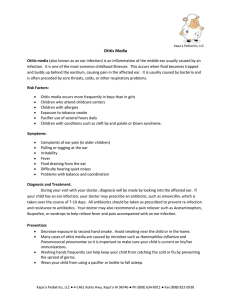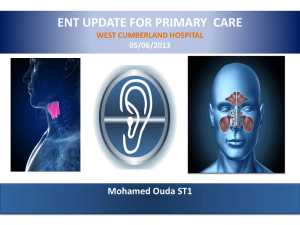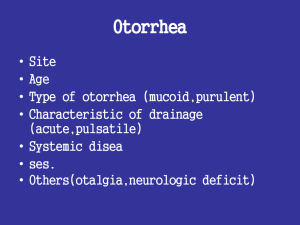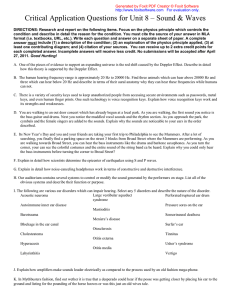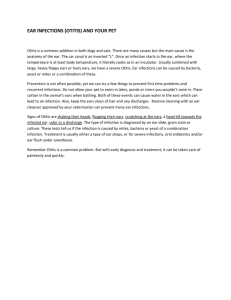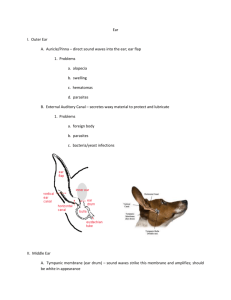Document 14233671
advertisement
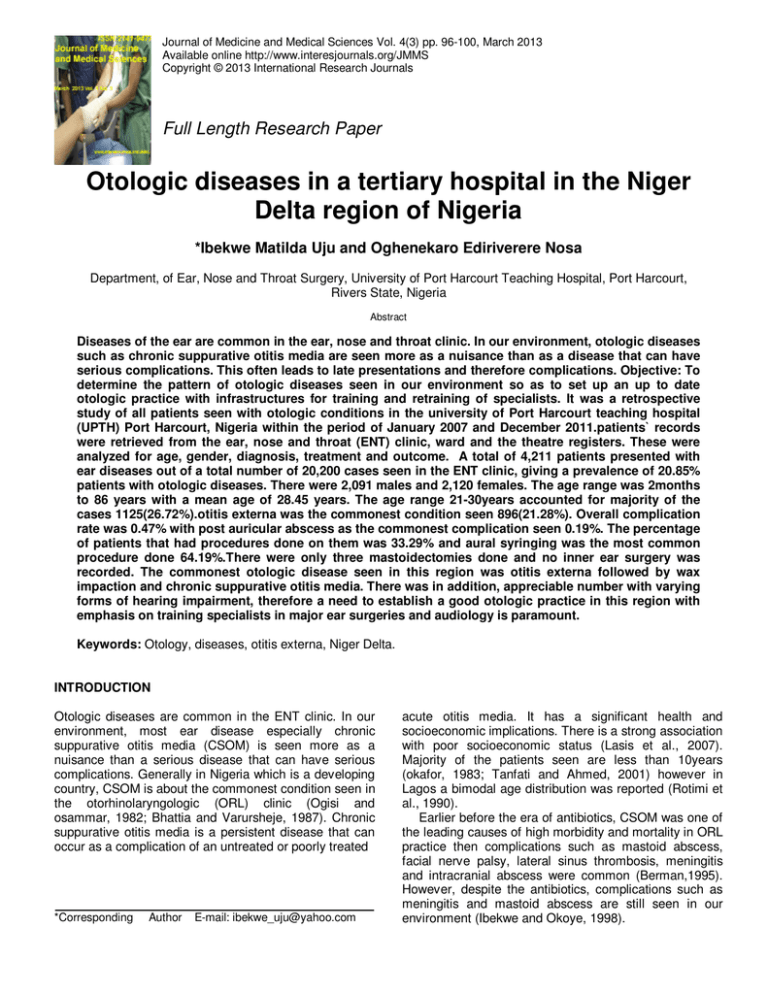
Journal of Medicine and Medical Sciences Vol. 4(3) pp. 96-100, March 2013 Available online http://www.interesjournals.org/JMMS Copyright © 2013 International Research Journals Full Length Research Paper Otologic diseases in a tertiary hospital in the Niger Delta region of Nigeria *Ibekwe Matilda Uju and Oghenekaro Ediriverere Nosa Department, of Ear, Nose and Throat Surgery, University of Port Harcourt Teaching Hospital, Port Harcourt, Rivers State, Nigeria Abstract Diseases of the ear are common in the ear, nose and throat clinic. In our environment, otologic diseases such as chronic suppurative otitis media are seen more as a nuisance than as a disease that can have serious complications. This often leads to late presentations and therefore complications. Objective: To determine the pattern of otologic diseases seen in our environment so as to set up an up to date otologic practice with infrastructures for training and retraining of specialists. It was a retrospective study of all patients seen with otologic conditions in the university of Port Harcourt teaching hospital (UPTH) Port Harcourt, Nigeria within the period of January 2007 and December 2011.patients` records were retrieved from the ear, nose and throat (ENT) clinic, ward and the theatre registers. These were analyzed for age, gender, diagnosis, treatment and outcome. A total of 4,211 patients presented with ear diseases out of a total number of 20,200 cases seen in the ENT clinic, giving a prevalence of 20.85% patients with otologic diseases. There were 2,091 males and 2,120 females. The age range was 2months to 86 years with a mean age of 28.45 years. The age range 21-30years accounted for majority of the cases 1125(26.72%).otitis externa was the commonest condition seen 896(21.28%). Overall complication rate was 0.47% with post auricular abscess as the commonest complication seen 0.19%. The percentage of patients that had procedures done on them was 33.29% and aural syringing was the most common procedure done 64.19%.There were only three mastoidectomies done and no inner ear surgery was recorded. The commonest otologic disease seen in this region was otitis externa followed by wax impaction and chronic suppurative otitis media. There was in addition, appreciable number with varying forms of hearing impairment, therefore a need to establish a good otologic practice in this region with emphasis on training specialists in major ear surgeries and audiology is paramount. Keywords: Otology, diseases, otitis externa, Niger Delta. INTRODUCTION Otologic diseases are common in the ENT clinic. In our environment, most ear disease especially chronic suppurative otitis media (CSOM) is seen more as a nuisance than a serious disease that can have serious complications. Generally in Nigeria which is a developing country, CSOM is about the commonest condition seen in the otorhinolaryngologic (ORL) clinic (Ogisi and osammar, 1982; Bhattia and Varursheje, 1987). Chronic suppurative otitis media is a persistent disease that can occur as a complication of an untreated or poorly treated *Corresponding Author E-mail: ibekwe_uju@yahoo.com acute otitis media. It has a significant health and socioeconomic implications. There is a strong association with poor socioeconomic status (Lasis et al., 2007). Majority of the patients seen are less than 10years (okafor, 1983; Tanfati and Ahmed, 2001) however in Lagos a bimodal age distribution was reported (Rotimi et al., 1990). Earlier before the era of antibiotics, CSOM was one of the leading causes of high morbidity and mortality in ORL practice then complications such as mastoid abscess, facial nerve palsy, lateral sinus thrombosis, meningitis and intracranial abscess were common (Berman,1995). However, despite the antibiotics, complications such as meningitis and mastoid abscess are still seen in our environment (Ibekwe and Okoye, 1998). Ibekwe and Oghenekaro 97 Acute otitis media in children are often missed by the pediatricians because of the initial onset of fever which is treated as malaria and only recognized when the ear begins to discharge (Amusa et al., 2005). They therefore present late to the ORL surgeon with complications or onset of hearing impairment. In Nigeria the untrained and unskilled practitioners especially in the rural areas still attend to a good percentage of the population (Akinpelu et al., 2008). There are two forms of CSOM; the atticoantral and tubotympanic type. In our environment, the tubotympanic type occurs more commonly. (Okafor, 1984). Diseases involving the external ears are also important with some being preventable. A lot of people are in the habit of using any handy objects to scratch their ears such as keys, match sticks, feathers, blades of grass etc and therefore are predisposed to infections and inflammations of the external ears or even tympanic membrane perforation. It is also known that preventable ear diseases constitute important health problem among children (Rao et al., 2002). Otologic practice in the developing countries has remained unsatisfactory and a review in a tertiary institution showed that minimal otologic surgeries are being done (Lasis et al., 2002). This study therefore is to determine the pattern of the otologic diseases seen in this region. And with this set up an up to date otologic practice and in addition, help to develop programs for the training of otology specialists for the developing countries. accounted for the highest number of cases 26.72% while age range 71+ was the least affected 1.85% (Table 1). Otitis externa was the commonest otologic disease in the study 896(21.28%). This was followed by wax impaction 857(20.35%) and CSOM 782(18.57%). Tumors of the ear were the least common 0.07% (Table 2). Majority of the CSOM was seen within the ages of 1130years while acute suppurative otitis media (ASOM) and otitis media with effusion (OME) were more in the below 10 years age group. All the CSOM in the study were of the tubotympanic type. There was no case of cholesteatoma recorded. Sensorineural hearing loss was the commonest form of hearing impairment 384(9.2%). The paediatric age group comprised 20% of this number. All the adult patients and children above 7 years with hearing impairment had pure tone audiometry carried out which is the only form of assessment available. There were no facility for accessing and fitting of hearing aids. About 33.29% of these patients had one form of otologic procedures or another done on them. Aural syringing was the commonest procedure done 900(64.19%). The only middle ear surgery done was mastoidectomy which was done in 0.21% of cases (Table 3). There were no inner ear or reconstructive surgeries recorded. The complications noted in the study were from CSOM. The overall complication rate was 0.47%. Post auricular abscess was the commonest, accounted for 0.19% of the complications (Table 4). PATIENTS AND METHODS DISCUSSION This is a retrospective study of all patients seen with otologic conditions at UPTH, Port Harcourt Nigeria within the period of January 2007 and December 2011.patients` records were retrieved from the Ear, Nose and Throat(ENT) clinics and ward registers and theatre registers. The following data were extracted and analyzed; age, gender, diagnosis, treatment and outcome. The data was analyzed by simple descriptive methods and results presented as tables of frequency and percentages for illustration. Patients with complaints to the ear without a clear otologic diagnosis were excluded from this study. Otologic diseases comprised 20.85% of all ENT cases seen within the period under study indicating that these diseases are common in ORL practice in our environment. This prevalence is however lower than 54% reported in Enugu (Okafor, 1983), 60% reported in Jos (Bhattia and varursheje, 1987), 56.3% in Kano (Salisu, 2010) and 57.8% in Nepal (Sigdel and Nepali, 2012). In this study, we had a close gender ratio with a slight female preponderance in contrast to some other researchers who had male preponderance (Okafor, 1983; Ologe et al., 2005).The reason for this is not clear from this study. The age range 21-30 years was most affected with a prevalence of 26.72% while the prevalence for children was 31% in contrast to the study in Kano where the age below 10 years was the most affected with prevalence of 33.4% (Salisu, 2010). Otitis externa accounted for the highest number of otologic cases seen. In contrast, other researchers found wax to be the commonest condition (Ologe et al., 2005; Adhikari, 2009). while some others found CSOM to be the highest (Salisu, 2010; Akinpelu and Amusa, 2007 ).It is known that high humidity and swimming may predis- RESULTS There were 4,211 patients that presented with otologic diseases out of 20,200 ENT cases seen within the period under study, giving a prevalence of 20.85% of patients with otologic diseases. There were 2,091 males and 2,120 females giving a male: female ratio of 1:1.06. The age range was from 2 months to 86 years with an average age of 28.45 years. The age range 21-30 years 98 J. Med. Med. Sci. Table 1. Age distribution. Age of patients(yrs) 0-10 11-20 21-30 31-40 41-50 51-60 61-70 71+ Total Number of patients 803 603 1125 824 393 241 144 78 4,211 Percentage (%) 19.07 14.32 26.72 19.57 9.33 5.72 3.42 1.85 100 Table 2. Disease distribution. Disease ASOM CSOM OME Otitis externa Sensorineural hearing loss Conductive hearing loss Merniere`s ds Presbyacusis Traumatic TM perforation Wax impaction Tinnitus Preauricular sinus Foreign body insertion Meatal atresia Tumors Facial nerve palsy Aural polyps Total Number of patients 296 782 329 896 384 60 68 59 170 857 178 15 61 8 3 11 34 4,211 Percentage (%) 7.03 18.57 7.81 21.28 9.12 1.42 1.61 1.40 4.04 20.35 4.23 0.36 1.45 0.19 0.07 0.26 0.81 100 Table 3. otologic procedures. Procedures Aural syringing Aural wick packing Foreign body extraction Aural polypectomy Preauricular sinus excision I&D post auricularabcess I&D preauricular sinus abscess Mastoidectomy Total Frequency 900 400 61 16 8 8 6 3 1,402 Table 4. Complications. Complications Post auricular abscess Facial nerve palsy Mastoid abscess Meningitis Total Frequency 8 6 4 2 20 There was no mortality recorded. Ibekwe and Oghenekaro 99 pose to external otitis and we are in the Niger delta known to have high humidity and swimming is a common leisure in this region. This may explain this finding. Wax impaction was second commonest condition found in the study with a prevalence of 20.35%, this is lower than two studies done in Nepal with prevalence of 33.4% (Sigdel and Nepali, 2012) and 62% (Adhikari, 2009). The last study was done on children in a rural setting while our study was hospital based. This figure was however higher than the 8.6% reported from a study in Kenya (Hatcher et al., 1995). It is known that factors such as temperature, humidity and racial differences are important in the production of wax and its impaction.Chronic suppurative otitis media is a major public health issue in developing countries. It ranked 3rd highest in our study 18.57% , higher than the 6% reported from south India (Rupal et al., 1999) and 12.4% from a study in Bangladesh (Biswas et al., 2005) however, it is lower than the prevalence recorded in Ife 33.9% (Akinpeluand Amusa, 2007) and Kano 25.4% (Salisu, 2010) both in Nigeria. In these last two studies it was the commonest otologic condition found. The tubotympanic type of CSOM only was seen in the study, similar to the findings of researchers from other centres; in Enugu 99 % (Okafor, 1984) while in Kano it was 96% (Salisu, 2010). There was no cholesteatoma in our series similar to other studies (Okafor, 1983; McCafferty, 1985). Africans are known to have low incidence of cholesteatoma (Belal Abdel, 1982). Possibly due to good aeration of the middle ear cleft (Ratnesar, 1976). Acute suppurative otitis media ranked 6th commonest condition with prevalence of 7.03% in contrast to other studies where it was the 3rd commonest otologic condition seen (Sigdel and Nepali, 2012; Akinpelu and Amusa, 2007). The prevalence was also similar to the 7.0% of (Akinpelu and Amusa, 2007). OME was 7.8% in this study higher than an earlier study in Ife which was 5.3% (Akinpelu and Amusa, 2007). It was lower than 20% from a study in rural India (Kishve et al., 2010). This may be due to population difference. The incidence is known to be decreasing as the age increases (Zeifel et al., 1999). Sensorineural hearing loss was the commonest form of hearing impairment in contrast to the study in Kano (Salisu, 2010) where it was the second commonest disorder with higher prevalence of 16%. In addition, we found birth asphyxia and neonatal jaundice implicated as underlying aetiological factors more than the reported bacterial meningitis. Pure tone audiometry was the only available means of assessment of these patients so only the adults and children up to the age of 7 years could be assessed in the centre while the very young had to be referred to audiological centre in Lagos or Warri for complete evaluation. Even then, those requiring hearing aids also had to procure them from such centres. Majority of the facial nerve palsy in our study were from complications of CSOM, 0.14% in contrast to other studies where trauma was the major cause 0.4% (Akinpelu and Amusa, 2007). Tinnitus accounted for 4.23% of the otologic consultations in this study and similar to the findings of other researchers, these patients were managed in the general ORL clinic and as such were rarely given the required degree of assessment. In addition, there is lack of proper diagnostic tools such as electrocochleography and electronystagmography which are very relevant in the management of these patients (Lin my et al., 2006; Salisu, 2010). The complications seen in this study was low; 0.47% and were from CSOM. Post auricular abscess was the commonest complication seen. It is known that the use of antibiotics has decreased the rate of complications of CSOM (Wusternberg et al., 2005). There was a paucity of procedures from the study, only 33.15% of the study population had any form of procedure done on them. Aural syringing was the most common procedure done 64.47%. This could be because it is incorporated as a major line of management in the patients with otitis externa and wax impaction. There were also minor surgeries such as foreign body extractions, preauricular sinus excision and incisions and drainage of abscesses. There were only three mastoidectomies done within this period. Majority of the CSOM were managed conservatively. Surgeries were reserved for those cases with complications. It is known that major indications for middle ear surgeries in developing countries were complications of CSOM (Okafor, 1984; Brobby, 1992). Low rate of middle ear surgeries were also reported in Ibadan (Lasis et al., 2002). This paucity of ear surgeries can be blamed on inadequate training, lack of relevant equipments such as microscopes, computerized tomography scan and magnetic resonance imaging machines, microsurgical instruments. It is of note that even the mastoidectomies here were done with the use of hammer and gouge. All these invariably affect training and acquisition of skills. It is known that high degree of exposure of trainees to tympanomastoid surgery corroborates well with subsequent successful outcome (Mahendran et al., 2006). CONCLUSION The diseases of the external and middle ear are commonly seen in this environment. There is also appreciable number with different forms of hearing impairment. There is therefore need to establish a well up to date otologic practice in terms of equipment and manpower training to meet the various aspects of the management of these patients including their rehabilitation. 100 J. Med. Med. Sci. REFERENCES Adhikari P (2009). Pattern of ear diseases in rural school children: experiences of free health camps Nepal. Int. J. Paediatr. Otorhinolaryngol. 73(9). Akinpelu OV, Amusa YB (2007). Otological diseases in Nigerian children. Int. J. Otorhinolaryngol. 7:1. Akinpelu OV, Amusa YB, Komolafe EO, Adeolu AA, Oladele AO, Ameye SA (2008). Challenges in management of chronic suppurative otitis media in a developing country. J. Laryngol. Otol. 122(1):16-20. Amusa YB, Ogunniyi TAB, Onayade OO, Okeowo PA (2005). Acute otitis media,malaria and pyrexia in the under five age group. WAJM. 24(3):40-42. Belal AA (1992). Otitis media In: Belal`s otolaryngology head and neck surgery. Alexandria Egypt: 20-22 Berman S (1995). Otitis media in developing countries. Paediatrics. 96(1pt1):126-31. Bhattia PL,Varursheje R (1987). Patterns of otorhinolaryngology disease in Jos community. Niger. Med. J.; 2:68-73 Biswas AC, Joarder AH, Siddiquee BH (2005). Prevalence of chronic suppurative otitis media among rural school going children. MymenSingh Med. J.; 14:152-55 Brobby GW (1992).The discharging ear in the tropics: A guide to diagnosis and management in the district hospital. Trop. Doct.; 22:103. Hatcher J, Smith A, Mackenzie I, Thompson S, Bal I, Macharia I, Mugwe P, Okoth-Olende C, Oburra H, Wanjohi Z, Achola N, Mirza N, Hart A (1995). A prevalence study of ear problems in school children in Kiambu district, Kenya. Int Pediatr. Otorhinolaryngol.; 33(3):197205. Ibekwe AO, Okoye BCC (1988). Subperiosteal mastoid abscesses in chronic suppurative otitis media. Ann. Otol. Rhinol. laryngol.; 97(4):373-378. Kishve SP, Kumar N, Kishve PS, Syed MMA, Kalakoti P (2010). Ear, Nose and Throat disorders in paediatric patients at a rural hospital in India. Australasian Med. J.; 12:786-90. Lasis AO, Suleiman OA, Afolabi OA (2007). Socioeconomic status and hearing loss in chronic suppurative otitis media in Nigeria. Ann. Trop. Paediatr.; 27(4):291-6. Lasis AO,Nwaorgu OG, Garndawa HI, Isa A(2002). A fifteen year review of otologic surgery in Ibadan, Nigeria: problems and prospects. Niger. J. Surg. Res.; 4:45-9. Lin MY, Timmer FC, Oriel BS, Zhou G, Guinan JJ, Kujawa SG, Herrmann BS (2006). Vestibular evoked myogenic potentials (VEMP) can detect asymptomatic saccular hydrops. Laryngoscope.; 116(6):987-92. Mahendran S, Benett AN, Jones SE, Yang BA, Prinsley PR (2006). Audit of specialist registrar training in tympano-mastoid surgery for chronic otitis media. J. Laryngol. Otol.; 120:193-9. McCafferty GJ, Lewis AN, Coman WB, Mills C (1985). A nine year study of ear diseases in Australian Aboriginal children. J. Otol. Laryngol.; 99:117-125. Ogisi FO, Osammar JY (1982). Bacteriology of chronic suppurative otitis media in Benin. Niger. Med. J.; 12:181-190. Okafor BC (1983). Otolaryngology in South Eastern Nigeria: pattern of diseases of the ear. Niger. Med. J. 13:11-19. Okafor BC (1984). The chronic discharging ear in Nigeria. J Laryngol Otol. 98(2):113-9. Ologe FE, Segun-Busari S, Abdulraheem IS, Afolabi AO (2005). Ear disease in elderly hospital patients in Nigeria. J Gerontol. A Biol. Sci.; 60(3):404-6. Rao RS, Subramanyam MA, Nair MS, Rajashekar B (2002). Hearing impairment and ear diseases among children of school entry age in rural south India.Int J Paediatric Otolrhinolaryngol. 64(2):105-10. Ratnesar P (1976). Chronic ear disease along the coasts of Labrador and Northern New found Land. J Otolaryngol. 5(2):122-30. Rotimi VO, Olabiyi DA, Banjo TO,Okeowo PA(1990).Randomized comparative efficacy of clindamycin,metronidazole and lincomycin plus gentamicin in CSOM. West Afri. J Med.; 9:89-97 Rupa V, Jacob A, Joseph A (1999). Chronic suppurative otitis media: prevalence and practices among rural south Indian children. Int. J. Pediatr. Otorhinolaryngol.; 48:217-21. Salisu AD (2010). Otology practice in a Nigerian tertiary health institution: a 10-year review. Ann. Afri Med.; 9:218-21. Sigdel B, Nepali R (2012). Pattern of ear disease among paediatric ENT patients: An experience from Tertiary care centre, Pokhara, Nepal. J. Nepal. Paediatr. Soc.; 32 (2):142-45. Tanfati OA, Ahmed BM (2000-2001). Bacteriology of chronic suppurative otitis media in Maiduguri, Northeastern Nigeria. J. Life Environ. Sci. 2/3:133-134. Wusternberg EG, Knothe J, Kittner T, Zahnert T (2005). Endocranial complications in otitis media: what you need to remember. MMW Fortschr. Med.; 147(12):52; 54-5. Zeizel SA, Roberts JE, Neebe EC, Riggins Jr R, Henderson FW (1999). A longitudinal study of OME among 2-to-5 year old African American children in child care. Pediatrics; 103(1):15-9.
